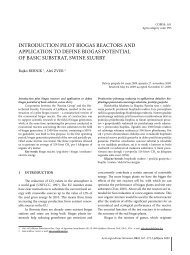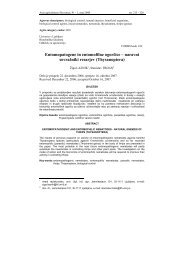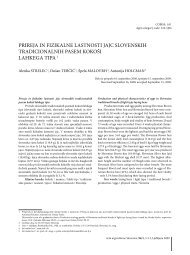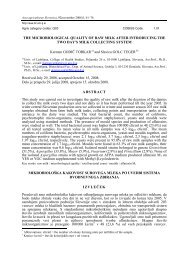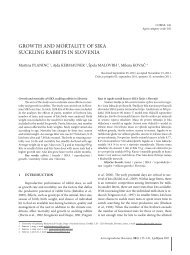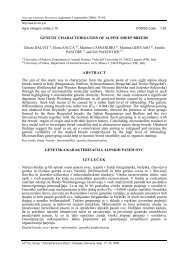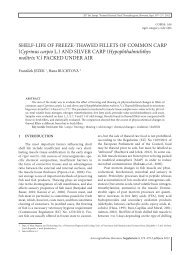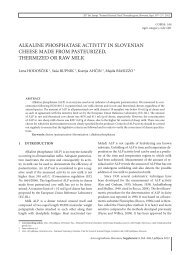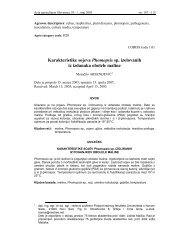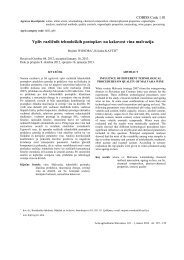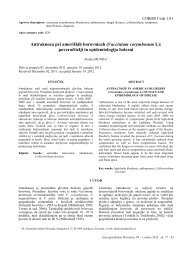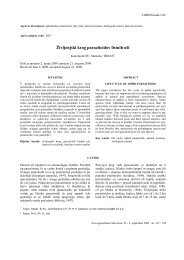multivariate analysis of phenotypic differentiation in bunaji and ...
multivariate analysis of phenotypic differentiation in bunaji and ...
multivariate analysis of phenotypic differentiation in bunaji and ...
You also want an ePaper? Increase the reach of your titles
YUMPU automatically turns print PDFs into web optimized ePapers that Google loves.
doi:10.2478/v10014-010-0018-9 COBISS: 1.01<br />
Agris category code: L01<br />
MULTIVARIATE ANALYSIS OF PHENOTYPIC<br />
DIFFERENTIATION IN BUNAJI AND<br />
SOKOTO GUDALI CATTLE<br />
Abdulmojeed YAKUBU 1, 2 , K<strong>in</strong>gsley Omogiade IDAHOR 1 , Hadiza Salihu HARUNA 1 , Matthew<br />
WHETO 3 , Samuel AMUSAN 3<br />
Multivariate <strong>analysis</strong> <strong>of</strong> <strong>phenotypic</strong> <strong>differentiation</strong> <strong>in</strong> Bunaji<br />
<strong>and</strong> Sokoto Gudali cattle<br />
The study aimed at exam<strong>in</strong><strong>in</strong>g morphometric <strong>differentiation</strong><br />
<strong>in</strong> two Nigerian breeds <strong>of</strong> cattle us<strong>in</strong>g multifactorial discrim<strong>in</strong>ant<br />
analyses. Ten morphological traits (withers height,<br />
rump height,chest circumference, body length, face length, tail<br />
length, rump length, head width, rump width <strong>and</strong> shoulder<br />
width) <strong>of</strong> 224 Bunaji <strong>and</strong> 87 Sokoto Gudali cattle were measured.<br />
The animals, which were aged 2.5−3.6 years, were subjected<br />
to extensive management system. The l<strong>in</strong>ear type traits<br />
<strong>of</strong> Sokoto Gudali cattle were significantly (P < 0.05) higher than<br />
those <strong>of</strong> their Bunaji counterparts, with the exception <strong>of</strong> body<br />
length <strong>and</strong> face length respectively. The stepwise discrim<strong>in</strong>ant<br />
<strong>analysis</strong> gave a better resolution as only three variables, rump<br />
width, withers height <strong>and</strong> face length were more discrim<strong>in</strong>at<strong>in</strong>g<br />
<strong>in</strong> separat<strong>in</strong>g the two cattle breeds. The Mahalanobis distance<br />
(7.19) between the two cattle populations was high <strong>and</strong><br />
significant, which is an <strong>in</strong>dication that they belong to genetically<br />
different groups. This was complemented by the result <strong>of</strong><br />
the Nearest Neighbour Discrim<strong>in</strong>ant Analysis, where 85.48% <strong>of</strong><br />
Bunaji cattle were classified <strong>in</strong>to their source population while<br />
96.55% <strong>of</strong> their Sokoto Gudali counterparts were correctly assigned<br />
<strong>in</strong>to their source genetic group. The present <strong>phenotypic</strong><br />
<strong>in</strong>formation will be the basis for the establishment <strong>of</strong> further<br />
characterization, conservation <strong>and</strong> selection strategies for the<br />
two Nigerian breeds <strong>of</strong> cattle.<br />
Key words: cattle / breeds / morphological traits / discrim<strong>in</strong>ant<br />
<strong>analysis</strong> / characterization / Nigeria<br />
1 Nasarawa State Univ., Fac. <strong>of</strong> Agriculture, Dept. <strong>of</strong> Animal Science, Keffi, Shabu-Lafia Campus, P.M.B. 135, Lafia, Nigeria<br />
2 Correspond<strong>in</strong>g author’s e-mail: abdul_mojeedy@yahoo.com<br />
3 Univ. <strong>of</strong> Agriculture, Dept. <strong>of</strong> Animal Breed<strong>in</strong>g <strong>and</strong> Genetics, Abeokuta, Nigeria<br />
Received June 07, 2010; accepted September 06, 2010.<br />
Delo je prispelo 07. junija 2010, sprejeto 06. septembra 2010.<br />
Multivariatna analiza fenotipskih razlik med “Bunaji” <strong>in</strong><br />
“Sokoto Gudali” govedom<br />
V študiji smo z multivariatno diskrim<strong>in</strong>antno analizo<br />
proučevali morfometrične razlike med dvema nigerijskima<br />
pasmama goveda. Merili smo deset morfoloških lastnosti<br />
(viš<strong>in</strong>a vihra, viš<strong>in</strong>a trupa, obseg prsi, dolž<strong>in</strong>a telesa, dolž<strong>in</strong>a<br />
glave, dolž<strong>in</strong>a repa, dolž<strong>in</strong>a trupa, šir<strong>in</strong>a glave, šir<strong>in</strong>a trupa <strong>in</strong><br />
šir<strong>in</strong>a pleč) pri 224 živalih pasme “Bunaji” <strong>in</strong> 87 živalih pasme<br />
“Sokoto Gudali”. Živali so bile v ekstenzivni reji, stare med 2,5<br />
ter 3,6 leti. Izmerjene vrednosti za l<strong>in</strong>earne lastnosti živali pasme<br />
“Sokoto Gudali” so bile statistično značilno večje (P < 0,05)<br />
kot pri živalih pasme “Bunaji”, izjema sta bila le dolž<strong>in</strong>a telesa<br />
<strong>in</strong> dolž<strong>in</strong>a glave. Za doseganje boljše resolucije smo uporabili<br />
postopno diskrim<strong>in</strong>antno analizo, ker so le tri spremenljivke,<br />
šir<strong>in</strong>a telesa, viš<strong>in</strong>a vihra <strong>in</strong> dolž<strong>in</strong>a glave, omogočile zanesljivo<br />
ločevanje obeh pasem. Mahalanobijeva distanca (7,19) med<br />
obema pasmama je bila visoko statistično značilna, kar nakazuje,<br />
da populaciji pripadata različnim pasemskim skup<strong>in</strong>am. Te<br />
rezultate potrjuje tudi diskrim<strong>in</strong>antna analiza najbližjih sosedov,<br />
kjer je bilo 85,48% “Bunaji” goveda razvrščenega v izvorno<br />
populacijo, medtem, ko je bil ta odstotek pri “Sokoto Gudali”<br />
pasmi še višji (96,55). Tako pridobljene fenotipske <strong>in</strong>formacije<br />
bomo uporabili za še natančnejši opis , zaščito <strong>in</strong> oblikovanje<br />
rejske strategije obeh nigerijskih pasem goveda.<br />
Ključne besede: govedo / pasme / morfološke lastnosti /<br />
diskrim<strong>in</strong>antna analiza / karakterizacija / Nigerija<br />
Acta argiculturae Slovenica, 96/2, 75–80, Ljubljana 2010
76<br />
A. YAKUBU et al.<br />
1 INTRODUCTION<br />
The wide range <strong>of</strong> breeds <strong>and</strong> species that have<br />
evolved <strong>in</strong> various environments represent unique sets <strong>of</strong><br />
genetic diversity. Genetic diversity has been def<strong>in</strong>ed as<br />
the variety <strong>of</strong> alleles <strong>and</strong> genotypes present <strong>in</strong> a population,<br />
<strong>and</strong> this is reflected <strong>in</strong> morphological, physiological<br />
<strong>and</strong> behavioural differences between <strong>in</strong>dividuals <strong>and</strong><br />
populations (Frankham et al., 2002). It is generally accepted<br />
that the highest amount <strong>of</strong> genetic diversity <strong>in</strong> the<br />
populations <strong>of</strong> livestock is found <strong>in</strong> the develop<strong>in</strong>g world<br />
where record keep<strong>in</strong>g is poor, <strong>and</strong> the risk <strong>of</strong> ext<strong>in</strong>ction<br />
high <strong>and</strong> on the <strong>in</strong>crease. Recently, loss <strong>of</strong> genetic diversity<br />
with<strong>in</strong> <strong>in</strong>digenous livestock breeds has been a major<br />
concern (Kastelic et al., 2005). Every year many species<br />
<strong>and</strong> breeds <strong>of</strong> animals become ext<strong>in</strong>ct thereby decreas<strong>in</strong>g<br />
the biodiversity <strong>and</strong> genetic variation <strong>of</strong> populations.<br />
Thus, breeds <strong>and</strong> species that have a tradition <strong>of</strong> breed<strong>in</strong>g<br />
for many a centuries, a unique genotype <strong>and</strong> aesthetic <strong>and</strong><br />
cultural value are be<strong>in</strong>g lost (Macijauskiene <strong>and</strong> Juras,<br />
2003; Adamczyk et al., 2008). Hence, need for susta<strong>in</strong>able<br />
management <strong>and</strong> conservation strategies for these animal<br />
genetic resources. S<strong>in</strong>ce the breed is the operational<br />
unit for the assessment <strong>of</strong> livestock diversity all over the<br />
world (Duchev <strong>and</strong> Groeneveld, 2006), contributions to<br />
characterization <strong>of</strong> local domestic animal populations<br />
are <strong>of</strong> major importance <strong>in</strong> develop<strong>in</strong>g countries.<br />
Characterization <strong>of</strong> livestock breeds is the first approach<br />
to a susta<strong>in</strong>able use <strong>of</strong> its animal genetic resources<br />
(Lanari et al., 2003). The first step <strong>of</strong> the characterization<br />
<strong>of</strong> local genetic resources is based on the knowledge <strong>of</strong><br />
variation <strong>in</strong> the morphological traits (Delgado et al.,<br />
2001). Morphometric measurements have been used to<br />
evaluate the characteristics <strong>of</strong> various breeds <strong>of</strong> animals,<br />
<strong>and</strong> could provide useful <strong>in</strong>formation on the suitability<br />
<strong>of</strong> animals for selection (Nesamvuni et al., 2000; Rastija<br />
et al., 2004; Araujo et al., 2006; Mwacharo et al., 2006;<br />
Mart<strong>in</strong>s et al., 2009; Yakubu, 2010). The outcome <strong>of</strong> genetic<br />
improvement programmes could also be evaluated<br />
on morphological basis (Riva et al., 2004). Although<br />
recent analyses have focused on molecular techniques,<br />
most mammalian species <strong>and</strong> subspecies orig<strong>in</strong>ally were<br />
described on the basis <strong>of</strong> morphological characteristics<br />
(Feldhamer et al., 2004). Previous efforts on the <strong>phenotypic</strong><br />
characterization <strong>of</strong> breeds <strong>of</strong> livestock have been<br />
restricted to the use <strong>of</strong> <strong>analysis</strong> <strong>of</strong> variance, whereas the<br />
current trend <strong>in</strong> livestock classification <strong>in</strong>volves the use<br />
<strong>of</strong> <strong>multivariate</strong> statistical tools (Traore et al., 2008; Yakubu<br />
<strong>and</strong> Ak<strong>in</strong>yemi, 2010). This is because univariate statistical<br />
<strong>analysis</strong>, accord<strong>in</strong>g to Dossa et al. (2007), analyze<br />
each variable separately <strong>and</strong> do not expla<strong>in</strong> how the populations<br />
under <strong>in</strong>vestigations differ when all measured<br />
morphological variables are considered jo<strong>in</strong>tly. Multi-<br />
Acta agriculturae Slovenica, 96/2 – 2010<br />
factorial discrim<strong>in</strong>ant analyses have been found to be<br />
more suitable <strong>in</strong> assess<strong>in</strong>g variation with<strong>in</strong> a population<br />
<strong>and</strong> can discrim<strong>in</strong>ate different population types when all<br />
measured morphological variables are considered jo<strong>in</strong>tly.<br />
Cattle are the s<strong>in</strong>gle most important livestock species<br />
<strong>in</strong> Nigeria <strong>in</strong> terms <strong>of</strong> animal prote<strong>in</strong>, value <strong>and</strong> biomass<br />
(Tewe, 1998). However, <strong>in</strong>formation is scanty on<br />
the morphological characteristics <strong>of</strong> <strong>in</strong>digenous cattle<br />
especially the Bunaji <strong>and</strong> Sokoto Gudali which constitute<br />
37.2 <strong>and</strong> 31.6% <strong>of</strong> the Nigerian cattle herd <strong>of</strong> 13,770,641<br />
(RIM, 1992). The research questions are: How morphologically<br />
heterogeneous are Nigerian breeds <strong>of</strong> cattle?<br />
And has the classification <strong>of</strong> Nigerian cattle <strong>in</strong>to different<br />
breeds any scientific support? The general objective <strong>of</strong><br />
the study is to characterize two <strong>in</strong>digenous cattle breeds<br />
<strong>of</strong> Nigeria based on morphological variation us<strong>in</strong>g <strong>multivariate</strong><br />
discrim<strong>in</strong>ant analyses, which could help <strong>in</strong> proper<br />
management, conservation <strong>and</strong> genetic improvement <strong>of</strong><br />
the local stock.<br />
2 MATERIALS AND METHODS<br />
2.1 EXPERIMENTAL ANIMALS AND LOCATION<br />
OF STUDY<br />
The experiment made use <strong>of</strong> a r<strong>and</strong>om sample <strong>of</strong><br />
211cattle <strong>of</strong> both sexes, compris<strong>in</strong>g 124 Bunaji <strong>and</strong> 87<br />
Sokoto Gudali, respectively. The animals were 2.5−3.6<br />
years old as determ<strong>in</strong>ed by dentition. They were reared<br />
through the extensive management system <strong>and</strong> orig<strong>in</strong>ated<br />
from different herds sampled <strong>in</strong> Nasarawa state, north<br />
central Nigeria. Efforts were made to restrict sampl<strong>in</strong>g<br />
to phenotipically pure Bunaji <strong>and</strong> Sokoto Gudali cattle<br />
respectively by measur<strong>in</strong>g only those that conformed to<br />
the classification descriptors <strong>of</strong> both breeds.<br />
2.2 MEASURED TRAITS<br />
Ten morphometric traits were measured on each<br />
animal. The body parameters were withers height (WH),<br />
rump height (RH), chest circumference (CC), body<br />
length (BL), face length (FL), tail length, rump length<br />
(RL), head width (HW), rump width (RW) <strong>and</strong> shoulder<br />
width (SW). Anatomical reference po<strong>in</strong>ts were as earlier<br />
described (Yakubu et al., 2009). The height measurement<br />
(cm) was done us<strong>in</strong>g a graduated measur<strong>in</strong>g stick. To<br />
achieve this, animals were placed on a flat ground <strong>and</strong><br />
held by two field assistants. The length <strong>and</strong> circumference<br />
measurements (cm) were effected us<strong>in</strong>g a tape rule<br />
while the width measurements (cm) were taken us<strong>in</strong>g a<br />
calibrated wooden calliper. All measurements were car-
Traits<br />
Withers height<br />
Rump height<br />
Chest circumference<br />
Body length<br />
Face length<br />
Tail length<br />
Rump length<br />
Head width<br />
Rump width<br />
Shoulder width<br />
MULTIVARIATE ANALYSIS OF PHENOTYPIC DIFFERENTIATION IN BUNAJI AND SOKOTO GUDALI CATTLE<br />
Table 1: Descriptive statistics <strong>of</strong> morphological traits <strong>of</strong> Bunaji <strong>and</strong> Sokoto Gudali cattle<br />
Preglednica 1: Opisna statistika morfoloških lastnosti “Bunaji” <strong>in</strong> “Sokoto Gudali” goveda<br />
ried out by the same person <strong>in</strong> order to avoid between<strong>in</strong>dividual<br />
variations.<br />
2.3 STATISTICAL ANALYSIS<br />
Bunaji Sokoto Gudali<br />
Mean ± SE SD CV Mean ± SE SD CV<br />
111.84 ± 0.98b 120.34 ± 1.01b 141.94 ± 1.62b 175.29 ± 2.25a 52.88 ± 0.49a 76.81 ± 0.97b 39.06 ± 0.42b 15.54 ± 0.14b 33.32 ± 0.44b 28.94 ± 0.43b 10.87 9.72 127.50 ± 0.53<br />
11.20 9.31<br />
18.07 12.73<br />
25.04 14.28<br />
5.48 10.36<br />
10.80 14.06<br />
4.73 12.11<br />
1.60 10.30<br />
4.95 14.86<br />
4.77 16.48<br />
a<br />
149.53 ± 1.55a 181.15 ± 1.92a 179.02 ± 1.55a 53.28 ± 0.34a 84.27 ± 0.41a 42.17 ± 0.31a 21.15 ± 0.41a 50.43 ± 1.02a 31.79 ± 0.28a 4.97 3.90<br />
14.43 9.65<br />
17.89 9.88<br />
14.41 8.05<br />
3.19 5.99<br />
3.87 4.59<br />
2.91 6.90<br />
3.80 17.97<br />
9.47 18.78<br />
2.58 8.12<br />
SE – St<strong>and</strong>ard error, SD – St<strong>and</strong>ard deviation, CV – Coefficient <strong>of</strong> variation.<br />
Means <strong>in</strong> the same row with different superscripts are significantly different (P < 0.05)<br />
The morphological traits were subjected to <strong>analysis</strong><br />
<strong>of</strong> variance to determ<strong>in</strong>e genotype effect us<strong>in</strong>g the MEAN<br />
procedure <strong>of</strong> SPSS (2001). Means were separated us<strong>in</strong>g<br />
the two-tailed, two-sample t-test <strong>of</strong> the same statistical<br />
package. Stepwise discrim<strong>in</strong>ant procedure (SAS, 1999)<br />
was applied us<strong>in</strong>g PROC STEPDISC to determ<strong>in</strong>e which<br />
morphological traits have more discrim<strong>in</strong>ant power than<br />
others. The relative importance <strong>of</strong> the morphometric<br />
variables <strong>in</strong> discrim<strong>in</strong>at<strong>in</strong>g between the two cattle populations<br />
was assessed us<strong>in</strong>g the level <strong>of</strong> significance, partial<br />
R 2 <strong>and</strong> F-statistic. The CANDISC procedure was used to<br />
perform univariate <strong>and</strong> <strong>multivariate</strong> one-way <strong>analysis</strong><br />
that calculated the Mahalanobis distance between the<br />
two cattle breeds. The ability <strong>of</strong> these canonical functions<br />
to assign each <strong>in</strong>dividual animal to its breed was calculated<br />
as the percentage <strong>of</strong> correct assignment to each<br />
genetic group us<strong>in</strong>g the DISCRIM procedure (Nearest<br />
Neighbour Discrim<strong>in</strong>ant Analysis).<br />
Table 2: Summary <strong>of</strong> stepwise selection <strong>of</strong> traits<br />
Preglednica 2: Povzetek postopnega izbora lastnosti<br />
3 RESULTS AND DISCUSSION<br />
Descriptive statistics <strong>of</strong> the morphological traits <strong>of</strong><br />
Bunaji <strong>and</strong> Sokoto Gudali cattle are presented <strong>in</strong> Table 1.<br />
Generally, the l<strong>in</strong>ear body measurements <strong>of</strong> Sokoto Gudali<br />
were significantly (P < 0.05) higher than those <strong>of</strong><br />
the Bunaji cattle with the exception <strong>of</strong> body length <strong>and</strong><br />
face length respectively. Comparative measurements <strong>of</strong><br />
morphometric traits can provide evidence <strong>of</strong> breed relationships<br />
<strong>and</strong> size. The considerable variation <strong>in</strong> body<br />
dimensions <strong>of</strong> the two cattle breeds might not be unconnected<br />
with <strong>in</strong>dividual breed’s potential <strong>and</strong> peculiarities.<br />
While the Bunaji cattle is noted for milk production,<br />
their Sokoto Gudali counterparts which rank second <strong>in</strong><br />
milk production produce more meat <strong>and</strong> appear to have<br />
more draught power than the former. The estimates obta<strong>in</strong>ed<br />
for height at withers <strong>of</strong> adult cattle <strong>in</strong> this study<br />
are comparable to those <strong>of</strong> the N<strong>and</strong>i (110–122 cm),<br />
Mongalla (100–110 cm) (Rege, 1999), Mexican Criollo<br />
Ch<strong>in</strong>ampo (101–117 cm) (Esp<strong>in</strong>oza et al., 2009) <strong>and</strong> Sudan<br />
Baggara (115.9–148.80 cm) (Alsiddig et al., 2010)<br />
cattle, respectively. The chest circumference values are,<br />
however, higher than the range <strong>of</strong> 122–127 cm reported<br />
for North Bengal Grey cattle <strong>in</strong> Bangladesh (Al-Am<strong>in</strong> et<br />
al., 2007).<br />
Variables<br />
Step entered Partial R2 Wilk’s<br />
Average squared<br />
canonical<br />
F-value Pr > F Lambda Pr < lambda correlation Pr > ASCC<br />
1 RW 0.5824 291.54 < 0.0001 0.417550 < 0.0001 0.582 < 0.0001<br />
2 WH 0.0948 21.67 < 0.0001 0.362555 < 0.0001 0.637 < 0.0001<br />
3 FL 0.0408 8.85 0.0033 0.400504 < 0.0001 0.599 < 0.0001<br />
RW – rump width, WH – withers height, FL – face length.<br />
Acta agriculturae Slovenica, 96/2 – 2010 77
78<br />
A. YAKUBU et al.<br />
The stepwise discrim<strong>in</strong>ant <strong>analysis</strong> showed that<br />
rump width, withers height <strong>and</strong> face length were the most<br />
discrim<strong>in</strong>at<strong>in</strong>g variables between Bunaji <strong>and</strong> Sokoto Gudali<br />
cattle (Table 2). Their respective partial R 2 <strong>and</strong> Fvalues<br />
were 0.5824, 0.0948 <strong>and</strong> 0.0408; 291.54, 21.67 <strong>and</strong><br />
8.85 with high significant values (P < 0.01–P < 0.0001).<br />
Morphological variables are easy to monitor <strong>and</strong> may facilitate<br />
the use <strong>of</strong> ethnological characterization <strong>and</strong> at the<br />
same time <strong>in</strong>stitute reliable racial discrim<strong>in</strong>ants (Herrera<br />
et al., 1996). The three morphological variables obta<strong>in</strong>ed<br />
<strong>in</strong> the present study are more important <strong>and</strong> <strong>in</strong>formative,<br />
<strong>and</strong> could be used to assign the two cattle breeds <strong>in</strong>to<br />
Table 3: Mahalanobis distance between Bunaji <strong>and</strong> Sokoto<br />
Gudali cattle<br />
Preglednica 3: Mahalanobijeve distance med “Bunaji” <strong>in</strong> “Sokoto<br />
Gudali” govedom<br />
Breed Bunaji Sokoto Gudali<br />
Bunaji<br />
Sokoto Gudali<br />
0<br />
7.19<br />
Acta agriculturae Slovenica, 96/2 – 2010<br />
7.19<br />
0<br />
dist<strong>in</strong>ct populations, thereby reduc<strong>in</strong>g the errors <strong>of</strong> selection<br />
<strong>in</strong> future breed<strong>in</strong>g <strong>and</strong> selection programmes.<br />
The Mahalanobis distance matrix is given <strong>in</strong> Table<br />
3. The pairwise distance (7.19) between the two cattle<br />
breeds was highly significant (P < 0.001). This was substantiated<br />
by the classification result (posterior probability<br />
<strong>of</strong> membership <strong>in</strong> each population). While 85.48% <strong>of</strong><br />
Bunaji cattle were classified <strong>in</strong>to their source population,<br />
96.55% <strong>of</strong> their Sokoto Gudali counterparts were correctly<br />
assigned <strong>in</strong>to their source genetic group (Table 4).<br />
The high morphological distance between the two cattle<br />
populations coupled with high correct assignment to<br />
source genetic groups is an <strong>in</strong>dication that they belong<br />
to different breeds. This could have been facilitated by<br />
the fact that measurements were restricted to <strong>phenotypic</strong>ally<br />
pure animals. The use <strong>of</strong> <strong>multivariate</strong> discrim<strong>in</strong>ant<br />
analyses therefore could be successfully used <strong>in</strong> morphometric<br />
<strong>differentiation</strong>. This is similar to the reports <strong>of</strong><br />
Table 4: Percent (%) <strong>of</strong> <strong>in</strong>dividual cattle classified <strong>in</strong>to breed<br />
Preglednica 4: Odstotek (%) osebkov, razvrščenih v posamezno<br />
pasmo<br />
Breed Bunaji Sokoto Gudali<br />
Bunaji<br />
Sokoto Gudali<br />
Error level<br />
Priors<br />
85.48<br />
3.45<br />
0.15<br />
0.50<br />
14.52<br />
96.55<br />
0.03<br />
0.50<br />
previous workers on goats (Dossa et al., 2007, Yakubu et<br />
al., 2010a,b <strong>and</strong> c), sheep (Traore et al. 2008; Yakubu <strong>and</strong><br />
Ak<strong>in</strong>yemi, 2010), cattle (Ndumu et al., 2008) <strong>and</strong> buffalo<br />
(Johari et al., 2009) respectively.<br />
The general aim <strong>of</strong> genetic conservation is to ma<strong>in</strong>ta<strong>in</strong><br />
with<strong>in</strong> <strong>and</strong> across breed diversity, where with<strong>in</strong><br />
breed diversity refers to the genetic management <strong>of</strong> one<br />
population <strong>and</strong> the across breed diversity implies the genetic<br />
management <strong>of</strong> many populations. With<strong>in</strong> breed<br />
diversity it is needed for the breed to genetically adapt<br />
to changes <strong>in</strong> the production <strong>and</strong> economic environment,<br />
<strong>and</strong> to avoid <strong>in</strong>breed<strong>in</strong>g problems. Across breed<br />
diversity is needed to provide alternatives if a breed happens<br />
to run <strong>in</strong>to genetic problems due to genetic drift or<br />
changes <strong>in</strong> the production systems (Meuwissen, 2009).<br />
Population studies which elucidate the relationship exist<strong>in</strong>g<br />
between the different breeds <strong>of</strong> a given species may<br />
<strong>of</strong>fer useful <strong>in</strong>formation for the conservation <strong>and</strong> management<br />
<strong>of</strong> animal genetic resources (AnGR) such as the<br />
evolution <strong>of</strong> the breeds, the development <strong>of</strong> gene pools<br />
<strong>and</strong> the magnitude <strong>of</strong> genetic <strong>differentiation</strong>. Accord<strong>in</strong>g<br />
to Mariante et al. (2008), national AnGR conservation<br />
programmes should use the association <strong>of</strong> <strong>phenotypic</strong><br />
data, molecular polymorphisms <strong>and</strong> adequate statistical<br />
methods which reflect the real condition <strong>of</strong> a population.<br />
This was buttressed by Berthouly et al. (2010) who studied<br />
genetic diversity <strong>of</strong> Vietnamese H’mong cattle us<strong>in</strong>g<br />
<strong>multivariate</strong> <strong>analysis</strong> on morphometric <strong>and</strong> genetic data.<br />
The present <strong>in</strong>formation on the <strong>phenotypic</strong> <strong>differentiation</strong><br />
<strong>of</strong> Bunaji <strong>and</strong> Sokoto Gudali could therefore be<br />
exploited <strong>in</strong> design<strong>in</strong>g appropriate strategies for their<br />
management <strong>and</strong> conservation. However, there is a need<br />
for a genetic study us<strong>in</strong>g prote<strong>in</strong> <strong>and</strong> DNA microsatellite<br />
markers to complement the results arisen from morphometric<br />
<strong>differentiation</strong> <strong>of</strong> the two most populous Nigerian<br />
breeds <strong>of</strong> cattle.<br />
4 CONCLUSIONS<br />
This study showed that Sokoto Gudali had higher<br />
mean values <strong>in</strong> withers height, rump height, chest circumference,<br />
tail length, rump length, head width, rump<br />
width <strong>and</strong> shoulder width compared to their Bunaji<br />
counterparts. The two cattle breeds were not significantly<br />
different <strong>in</strong> body length <strong>and</strong> face length respectively.<br />
However, rump width, withers height <strong>and</strong> face length<br />
were found to be the most discrim<strong>in</strong>at<strong>in</strong>g variables to<br />
assign Bunaji <strong>and</strong> Sokoto Gudali cattle <strong>in</strong>to dist<strong>in</strong>ct genetic<br />
groups. However, the present <strong>in</strong>formation on the<br />
morphometric <strong>differentiation</strong> <strong>of</strong> Bunaji <strong>and</strong> Sokoto Gudali<br />
breeds <strong>of</strong> cattle could be complemented with genetic<br />
characterization us<strong>in</strong>g biochemical <strong>and</strong> DNA markers.
MULTIVARIATE ANALYSIS OF PHENOTYPIC DIFFERENTIATION IN BUNAJI AND SOKOTO GUDALI CATTLE<br />
This could aid field assessment, management <strong>and</strong> conservation<br />
<strong>of</strong> the two cattle populations, where the goal is<br />
to obta<strong>in</strong> <strong>phenotypic</strong>ally pure local genetic resources for<br />
future selection <strong>and</strong> breed<strong>in</strong>g improvement strategies.<br />
5 REFERENCES<br />
Adamczyk K., Felenczak A., Jamrozy J., Szarek J., Bulla, J. 2008.<br />
Conservation <strong>of</strong> Polish Red cattle. Slovak J. Anim. Sci., 41:<br />
72–76<br />
Al-Am<strong>in</strong> M., Nahar A., Bhuiyan A.K.F.H., Faruque M.O. 2007.<br />
On-farm characterization <strong>and</strong> present status <strong>of</strong> North Bengal<br />
Grey (NBG) cattle <strong>in</strong> Bangladesh. AGRI, 40: 55–64<br />
Alsiddig M.A., Babiker S.A. Galal M.Y., Mohammed A.M. 2010.<br />
Phenotypic characterization <strong>of</strong> Sudan Zebu cattle (Baggara<br />
type). Res. J. Anim. Vet. Sci., 5: 10–17<br />
Araujo J.P., Machado H., Cantalapiedra J., Iglesias A., Petim-<br />
Batista F., Colaco J., Sanchez L. 2006. Biometric <strong>analysis</strong> <strong>of</strong><br />
Portuguese M<strong>in</strong>hota cattle. Proceed<strong>in</strong>gs 8 th World Congress<br />
on Genetics Applied to Livestock Production, 13–18 Aug.<br />
2006, Belo Horizonte, MG, Brazil<br />
Berthouly C., Maillard J.C., Phan Doan L., Nhu Van T.,<br />
Bed’Hom B., Leroy G., Hoang Thanh H., Laloe D., Bruneau<br />
N., Vu Chi C., Nguyen Dang V., Verrier E., Rognon X. 2010.<br />
Reveal<strong>in</strong>g f<strong>in</strong>e scale subpopulation structure <strong>in</strong> the Vietnamese<br />
H’mong cattle breed for conservation purposes.<br />
BMC Genetics, 11: 45, doi:10.1186/1471-2156-11-45<br />
Delgado J.V., Barba C., Camacho M.E., Sereno F.T.P.S., Mart<strong>in</strong>ez<br />
A. Vega-Pla J.L. 2001. Livestock characterisation <strong>in</strong><br />
Spa<strong>in</strong>. Animal Genetic Resources Information, 29: 7–18<br />
Dossa L.H., Wollny C., Gauly M. 2007. Spatial variation <strong>in</strong> goat<br />
populations from Ben<strong>in</strong> as revealed by <strong>multivariate</strong> <strong>analysis</strong><br />
<strong>of</strong> morphological traits. Small Rum<strong>in</strong>. Res., 73: 150–159<br />
Duchev Z., Groeneveld E. 2006. Improv<strong>in</strong>g the monitor<strong>in</strong>g<br />
<strong>of</strong> animal genetic resources on national <strong>and</strong> <strong>in</strong>ternational<br />
level. Arch. Tierz. Dummerstorf, 49: 532–544<br />
Esp<strong>in</strong>oza J.L., Guevara J.A., Palacios, A. 2009. Morphometric<br />
<strong>and</strong> phaneroptic characterization <strong>of</strong> Mexican Criollo<br />
Ch<strong>in</strong>ampo cattle. Arch. Zootec., 58: 277–279<br />
Feldhamer G.A., Drickamer L.C., Vessey S.H., Merritt J.F. 2004.<br />
Mammalogy: adaptation, diversity, ecology. McGraw Hill,<br />
Boston, Massachusetts, USA<br />
Frankham R., Ballou J.D., Briscoe D.A. 2002. Introduction to<br />
conservative genetics. Cambridge University Press.<br />
Herrera M., Rodero E., Gutierrez M.J., Pena, F., Rodero J.M.<br />
1996. Application <strong>of</strong> multifactorial discrim<strong>in</strong>ant <strong>analysis</strong> <strong>in</strong><br />
the morphostructural <strong>differentiation</strong> <strong>of</strong> Andalusian capr<strong>in</strong>e<br />
breeds. Small Rum<strong>in</strong>. Res., 22: 39–47<br />
Johari S., Kurnianto E., Sutopo S., Hamayanti W.A. 2009. Multivariate<br />
<strong>analysis</strong> on <strong>phenotypic</strong> traits <strong>of</strong> body measurement<br />
<strong>in</strong> swamp buffalo (Bubalus bubalis). J. Indone. Trop. Anim.<br />
Agric., 34: 289–294<br />
Kastelic M., Zan Lotric M., Kompan D. 2005. L<strong>in</strong>ear body measurements<br />
<strong>of</strong> Cika cattle <strong>in</strong> comparison to P<strong>in</strong>zgauer cattle.<br />
Acta Agriculturae Slovenica, 86, 2: 85–91<br />
Lanari M.R., Taddeo H., Dom<strong>in</strong>go E., Centeno M.P., Gallo L.<br />
2003. Phenotypic <strong>differentiation</strong> <strong>of</strong> exterior traits <strong>in</strong> local<br />
Criollo goat population <strong>in</strong> Patagonia (Argent<strong>in</strong>a). Arch.<br />
Tierz. Dummerstorf, 46: 347–356<br />
Macijauskiene V., Juras R. 2003. An Attempt at analyz<strong>in</strong>g the<br />
selected traits <strong>of</strong> body conformation, growth, performance<br />
<strong>and</strong> genetic structure <strong>of</strong> Lithuanian native Zemaitukai<br />
horse, the breed be<strong>in</strong>g preserved from ext<strong>in</strong>ction. Animal<br />
Science Papers <strong>and</strong> Reports, 21: 35–46<br />
Mariante A.S., Egito A.A., Albuquerque M.S.M., Paiva S.R.,<br />
Ramos A.S. 2008. Manag<strong>in</strong>g genetic diversity <strong>and</strong> society<br />
needs. Revista Brasileira de Zootecnia, 37, doi:10.1590/<br />
S1516-35982008001300016<br />
Mart<strong>in</strong>s C.E.N., Quadros S.A.F., Tr<strong>in</strong>dade J.P.P., Quadros F.L.F.,<br />
Costa J.H.C., Raduenz G. 2009. Shape <strong>and</strong> function <strong>in</strong> Braford<br />
cows: The body shape as an <strong>in</strong>dicative <strong>of</strong> performance<br />
<strong>and</strong> temperament. Arch. Zootec., 58: 425–433<br />
Meuwissen A., 2009. Genetic management <strong>of</strong> small populations:<br />
A review. Acta Agriculturae Sc<strong>and</strong>, Section A, 59:<br />
71–79<br />
Mwacharo J.M., Okeyo A.M., Kam<strong>and</strong>e G.K. Rege J.E.O. 2006.<br />
The small East African shorthorn zebu cows <strong>in</strong> Kenya. 1:<br />
L<strong>in</strong>ear body measurements. Trop. Anim. Health Prod., 38:<br />
65–76<br />
Ndumu D.B., Baumung R., Hanotte O., Wurz<strong>in</strong>ger M., Okeyo<br />
M.A., Jianl<strong>in</strong> H., Kibogo H., Solkner J. 2008. Genetic <strong>and</strong><br />
morphological characterization <strong>of</strong> the Ankole Longhorn<br />
cattle <strong>in</strong> the African Great Lakes region. Genet. Sel. Evol.,<br />
40: 467–490<br />
Nesamvuni A.E., Mulaudzi J., Ramanyimi N.D., Taylor G.J.<br />
2000. Estimation <strong>of</strong> body weight <strong>in</strong> Nguni-type cattle under<br />
communal management conditions. S. J. Anim. Sci., 30<br />
(Supplement 1): 97–98<br />
Rastija T., Baban M., Antunovic Z., M<strong>and</strong>ic I. 2004. A comparison<br />
<strong>and</strong> development <strong>of</strong> morphometric characteristics <strong>of</strong><br />
stallions <strong>and</strong> mares on the Lipizzaner stud <strong>of</strong> Dakovo. Acta<br />
Agriculturae Slovenica, Supplement 1: 195–200<br />
Rege J.E.O. 1999. The state <strong>of</strong> African cattle genetic resources I.<br />
Classification framework <strong>and</strong> identification <strong>of</strong> threatened<br />
<strong>and</strong> ext<strong>in</strong>ct breeds. FAO/UNEP Animal Genetic Resources<br />
Information Bullet<strong>in</strong>, 26: 1–26<br />
RIM 1992. Nigerian Livestock Resources: National Synthesis.<br />
Jersey, UK, Resource Inventory <strong>and</strong> Management Ltd.<br />
SAS. 1999. Statistical Analysis System User’s guide: Statistic.<br />
Cary, NC 27513, U.S.A., SAS Institute Inc.<br />
SPSS. 2001. Statistical Package for the Social Sciences. New<br />
York, SPSS Inc.<br />
Tewe O.O. 1998. Susta<strong>in</strong>ability <strong>and</strong> Development: Paradigms<br />
from Nigeria Livestock Industry. University Inaugural Lecture<br />
delivered on October 9, 1997 on behalf <strong>of</strong> the Faculty<br />
<strong>of</strong> Agriculture <strong>and</strong> Forestry, University <strong>of</strong> Ibadan, Ibadan<br />
Yakubu A., Ogah D.M., Idahor K.O. 2009. Pr<strong>in</strong>cipal component<br />
<strong>analysis</strong> <strong>of</strong> the morphostructural <strong>in</strong>dices <strong>of</strong> White Fulani<br />
cattle. Trakia J. Sci., 7: 67–73<br />
Yakubu A. 2010. Path coefficient <strong>and</strong> path <strong>analysis</strong> <strong>of</strong> body<br />
weight <strong>and</strong> biometric traits <strong>in</strong> Yankasa lambs. Slovak J.<br />
Anim. Sci., 43: 17–25<br />
Yakubu A., Salako A.E., Imumor<strong>in</strong>, I.G. 2010a. Multivariate<br />
<strong>analysis</strong> <strong>of</strong> spatial patterns <strong>of</strong> morphological traits <strong>in</strong> West<br />
African Dwarf goats <strong>in</strong> three agro-ecological zones <strong>of</strong> Nigeria.<br />
J. Appl. Anim. Res., (<strong>in</strong> press)<br />
Acta agriculturae Slovenica, 96/2 – 2010 79
80<br />
A. YAKUBU et al.<br />
Yakubu A., Salako A.E., Imumor<strong>in</strong> I.G., Ige A.O., Ak<strong>in</strong>yemi<br />
M.O. 2010b. Discrim<strong>in</strong>ant <strong>analysis</strong> <strong>of</strong> morphometric <strong>differentiation</strong><br />
<strong>in</strong> the West African Dwarf <strong>and</strong> Red Sokoto goats.<br />
S. Afr. J. Anim. Sci., 40, (<strong>in</strong> press)<br />
Yakubu A., Salako A.E., Imumor<strong>in</strong> I.G. 2010c. Comparative<br />
<strong>multivariate</strong> <strong>analysis</strong> <strong>of</strong> biometric traits <strong>of</strong> West African<br />
Acta agriculturae Slovenica, 96/2 – 2010<br />
Dwarf <strong>and</strong> Red Sokoto goats. Trop. Anim. Health Prod. (accept<br />
with m<strong>in</strong>or revision)<br />
Yakubu, A. <strong>and</strong> Ak<strong>in</strong>yemi, M.O. 2010. An evaluation <strong>of</strong> sexual<br />
size dimorphism <strong>in</strong> Uda sheep us<strong>in</strong>g multifactorial discrim<strong>in</strong>ant<br />
<strong>analysis</strong>. Acta Agriculturae Sc<strong>and</strong> Section A, 60:<br />
74–78



